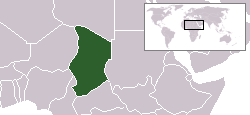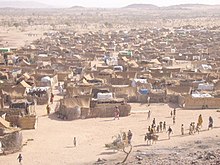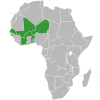| Chad | |
 | |
Location  | |
Coat of arms and flag  | |
| Capital | N'Djamena |
|---|---|
| Government | presidential republic |
| Currency | Central African CFA Franc (XAF) |
| Surface | 1,284,000 km² |
| Inhabitants | 10.329.208 (2009 estimate), 6.279.921 (1993 census) |
| Tongue | French is Arabic |
| Religion | Islam (53%), Christianity (34%), Animism (10%), others 3% (2009) |
| Electricity | 230V / 50Hz (British and European plug) |
| Prefix | 235 |
| TLD | .td |
| Time zone | UTC 1 |
Chad is a state ofSaharan Africa which borders to the north with the Libya, to the east with the Sudan, south la Central African Republic, southwest with the Cameroon and the Nigeria and to the west the Niger.
To know
Chad is a country ofSaharan Africa, one of the least densely populated in theAfrica. The state can be divided in two, in the north a desert part full of oases, and in the south the savannah. In the southern part are the capital and Lake Chad which has dried up a lot in recent years. The state maintains an almost intact environment and ethnic diversity that can be seen in the numerous markets.
Geographical notes
The territory of Chad is included in a huge penepiano that slopes to the west into the depression of Lake Chad giving rise to an immense basin bounded to the north by the Tibesti massif, to the east by the Ennedi plateau and the Ouaddaï hills and to the south by the ridge The lowest point is located near lakes Chad and Fitri in the Bodele Depression, a large area occupied by sandy ergs. East of Lake Chad extends the Sahel while further south there is an area covered with savannas The southernmost part of the country is flat with savannahs and thick vegetation especially along the waterways, to the south-east is the Bongos massif.
In the northern part we find the Sahara desert where some mountain ranges wind and where we find the Ribesti, a massif of volcanic origin. The highest peak of the Ribesti is Emi Koussi, 3,415 meters.
Lake Chad, which is located between Chad and Cameroon, used to be the second largest lake in Africa but has shrunk dramatically over the past two decades and its area is now 10% of what it was previously.
When to go
Chad has four climate zones: vast and arid lowlands in the center, desert in the north, dry mountains in the north west, and tropical lowlands in the south. Proceeding south we pass from a desert climate with a very short or no wet season to a tropical one in which the wet season lasts even six / seven months with violent downpours. In the dry season, which culminates in January, the harmattan often blows, an intense wind that blows from the Sahara to the Gulf of Guinea. Environmental hazards in Chad include periodic droughts and the plague of locusts.
Background
Archaeological remains, including rock arts, show that Chad was already inhabited in prehistoric times. During the Middle Ages the territory was a crossroads for trade between the Arabs and local populations. In 1891 it became a French colony and then gained independence on 11 August 1960. From 1975 to 1987, the north of Chad was the scene of wars against troops Libyans.
On 23 December 2005, the government of Chad declared a state of war against Sudan, accusing it of having carried out attacks on the border villages between the two nations.
Spoken languages
In addition to the two official languages (i.e. French and Arabic), more than 150 local languages and dialects are spoken in Chad.The main language groups are:
- Sara-Bongo-Baguirmien (Sara, Bilala, Kenga);
- Chadian (Massa, Kabalaye, Toumak, Dangleat);
- Arabic;
- eastern Adamaoua (Toupouri, Mboum, Kim, Mesme, Moundang);
- Central Saharan (Kanembou, Kanouri, Teda, Daza, Baele).
Culture and traditions
In the streets of the capital you can hear the Arab musicians playing their traditional music, which with their songs and their narrations represent the living memory of the traditions of the Arab people.
Suggested readings
- M J Azevedo and Emmanuel Nnadozie, Chad: A Nation in Search of its Future, Westview Press Inc., 1997
- M J Azevedo, Roots of Violence: History of War in Chad, Routledge, 1998
- Zuchora-Walske, Christine, Chad in Pictures, Twenty-First Century Books, 2009
- André Gide Return to Chad, Longanesi 1969.
Territories and tourist destinations
Chad was divided into 22 regions, each of which is made up of 2-4 departments. The regions roughly correspond to the 14 Chadian prefectures that have existed since 1999.

Urban centers
- N'Djamena - The capital.
- Abéché - Capital of the Ouaddaï region, once the capital of the Ouaddaï kingdom.
- Faya Largeau - Capital of the Borkou region and the most important city in the north.
- Moundou - The second largest city located south of the country.

How to get
Entry requirements
Passport, visa and international vaccination certificate. Since there is no Chadian diplomatic representation in Italy, it is necessary to contact the Chadian Embassy in Paris: then send them your passport, yellow fever vaccination, invitation letter, completed form, return flight booking and 70 euros of contributions.The yellow fever vaccination is mandatory for all travelers, regardless from the origin.
Citizens of the following countries do not need a visa: Benin, Burkina Faso, Cameroon, Central African Republic, Republic of the Congo, Ivory Coast, Gabon, Equatorial Guinea, Mauritania, Niger is Senegal.
By car
It is not possible to arrive in Chad by ship unless illegally crossing Lake Chad.
On the train
There are no railway lines that can be used to get to the country.
How to get around

What see
- Lake Chad - One of the largest lakes in the world.
- National Museum - Located ad N'Djamena.
- Gaoui - A village north of N'Djamena which was once the capital of the Sao people.
What to do
Currency and purchases
 CEMAC - Map of participating countries  CFA Franc - Map of participating countries |
|  UEMOA - Acceding countries map  1 CFA Franc coin |
Below are the links to know the current exchange rate with the main world currencies:
| (EN) With Google Finance: | AUDCADCHFEURGBPHKDJPYUSD |
| With Yahoo! Finance: | AUDCADCHFEURGBPHKDJPYUSD |
| (EN) With XE.com: | AUDCADCHFEURGBPHKDJPYUSD |
| (EN) With OANDA.com: | AUDCADCHFEURGBPHKDJPYUSD |
At the table
The difficult living conditions of the population of Chad have greatly influenced the way of cooking of this poor population. Fishing is very popular, even if by women. But the foods are enriched with spices, the most cultivated vegetables are tomatoes, rice, cereals and peanuts. Among the best known specialties we have Shay (boiling tea and sugar), Kouroundjal (tea based on ginger) and Karkandji (tea based on carcadè).
Tourist infrastructure
Events and parties
National holidays
| Date | Festivity | Note | |
|---|---|---|---|
| January | New Year | International holiday | |
| March April | Easter | Christian holiday | |
| May | Workers Day | International holiday | |
| August | Independence Day | Independence from France (1960). | |
| November | All Saints | Christian holiday | |
| November | Republic Day | Memorial of the proclamation of the republic (1958) | |
| December | Festival of freedom and democracy | Memorial to the coup with which Idriss Déby became president (1990) | |
| December | Christmas | Christian holiday that marks the birth of Christ | |
| muharram | Ras as-Sana | Muslim holiday that marks the beginning of the Islamic New Year | |
| rabi 'al-awwal | Mawlid | Muslim holiday that marks the birth of the Prophet Muhammad | |
| shawwal | Id al-fitr | Muslim holiday that marks the end of Ramadan | |
| dhul-hijja | Id Al Adha | Muslim festival of sacrifice or ram also called Tabaski or Id El Kabir (great festival) | |
When the Independence Day and the Republic Day fall on Sunday, the holiday can be postponed to the following Monday.
Being a predominantly Muslim nation, all the recurrences of Islam are celebrated.
Safety
Before embarking on the journey consult:
- Safe travel - Ministry of Foreign Affairs (Farnesina) (Country safety information).
The eastern and northern areas are to be avoided due to the presence of banditry and rebel movements. N'Djamena it is a city where caution must be taken at night for petty crime.
Health situation
Healthcare facilities are below the western level.
It is advisable to avoid consuming raw food, unwashed vegetables, water from the urban network, ice in drinks.
For travel to the country, the yellow fever vaccine is mandatory. Antimalarial prophylaxis and typhoid and hepatitis A and B vaccinations are recommended.
Respect the customs
Ramadan is the ninth and holiest month in the Islamic calendar and lasts 29-30 days. Muslims fast every day for its entire duration and most restaurants will be closed until dusk. Nothing (including water and cigarettes) should pass through the lips from sunrise to sunset. Foreigners and travelers are exempt, but should still refrain from eating or drinking in public as it is considered rude. Working hours are also decreasing in the corporate world. The exact dates of Ramadan depend on local astronomical observations and may vary from country to country. Ramadan ends with the feast of Eid al-Fitr, which can take several days, usually three in most countries.
- 13 April - 12 May 2021 (1442 AH)
- 2 April - 1 May 2022 (1443 AH)
- 23 March - 20 April 2023 (1444 AH)
- 11 March - 9 April 2024 (1445 AH)
- 1 March - 29 March 2025 (1446 AH)
If you are planning to travel to Chad during Ramadan, consider reading the article Traveling during Ramadan.
How to keep in touch
Other projects
 Wikipedia contains an entry concerning Chad
Wikipedia contains an entry concerning Chad Commons contains images or other files on Chad
Commons contains images or other files on Chad Wikinews contains current news on Chad
Wikinews contains current news on Chad
![]() Algeria ·
Algeria · ![]() Angola ·
Angola · ![]() Benin ·
Benin · ![]() Botswana ·
Botswana · ![]() Burkina Faso ·
Burkina Faso · ![]() Burundi ·
Burundi · ![]() Cameroon ·
Cameroon · ![]() Cape Verde ·
Cape Verde · ![]() Chad ·
Chad · ![]() Comoros ·
Comoros · ![]() Ivory Coast ·
Ivory Coast · ![]() Egypt ·
Egypt · ![]() Eritrea ·
Eritrea · ![]() eSwatini ·
eSwatini · ![]() Ethiopia ·
Ethiopia · ![]() Gabon ·
Gabon · ![]() Gambia ·
Gambia · ![]() Ghana ·
Ghana · ![]() Djibouti ·
Djibouti · ![]() Guinea ·
Guinea · ![]() Guinea-Bissau ·
Guinea-Bissau · ![]() Equatorial Guinea ·
Equatorial Guinea · ![]() Kenya ·
Kenya · ![]() Lesotho ·
Lesotho · ![]() Liberia ·
Liberia · ![]() Libya ·
Libya · ![]() Madagascar ·
Madagascar · ![]() Malawi ·
Malawi · ![]() Mali ·
Mali · ![]() Morocco ·
Morocco · ![]() Mauritania ·
Mauritania · ![]() Mauritius ·
Mauritius · ![]() Mozambique ·
Mozambique · ![]() Namibia ·
Namibia · ![]() Niger ·
Niger · ![]() Nigeria ·
Nigeria · ![]() Central African Republic ·
Central African Republic · ![]() Republic of the Congo ·
Republic of the Congo · ![]() Democratic Republic of Congo ·
Democratic Republic of Congo · ![]() Rwanda ·
Rwanda · ![]() São Tomé and Príncipe ·
São Tomé and Príncipe · ![]() Senegal ·
Senegal · ![]() Seychelles ·
Seychelles · ![]() Sierra Leone ·
Sierra Leone · ![]() Somalia ·
Somalia · ![]() South Africa ·
South Africa · ![]() Sudan ·
Sudan · ![]() Southern Sudan ·
Southern Sudan · ![]() Tanzania ·
Tanzania · ![]() Togo ·
Togo · ![]() Tunisia ·
Tunisia · ![]() Uganda ·
Uganda · ![]() Zambia ·
Zambia · ![]() Zimbabwe
Zimbabwe
States de facto independent: ![]() Somaliland
Somaliland
Territories with status indefinite: ![]() Western Sahara
Western Sahara
Addictions French: ![]() Mayotte ·
Mayotte · ![]() Meeting ·
Meeting · ![]() Scattered islands of the Indian ocean
Scattered islands of the Indian ocean
Addictions British: ![]() Saint Helena, Ascension and Tristan da Cunha
Saint Helena, Ascension and Tristan da Cunha
African territories Italians: ![]() Lampedusa ·
Lampedusa · ![]() Street lamp
Street lamp
African territories Portuguese: ![]() Madeira (
Madeira (![]() Wild Islands)
Wild Islands)
African territories Spaniards: ![]() Ceuta ·
Ceuta · ![]() Canary Islands ·
Canary Islands · ![]() Melilla ·
Melilla · ![]() Plazas de soberanía (Chafarinas · Peñón de Alhucemas · Peñón de Vélez de la Gomera · Perejil)
Plazas de soberanía (Chafarinas · Peñón de Alhucemas · Peñón de Vélez de la Gomera · Perejil)

